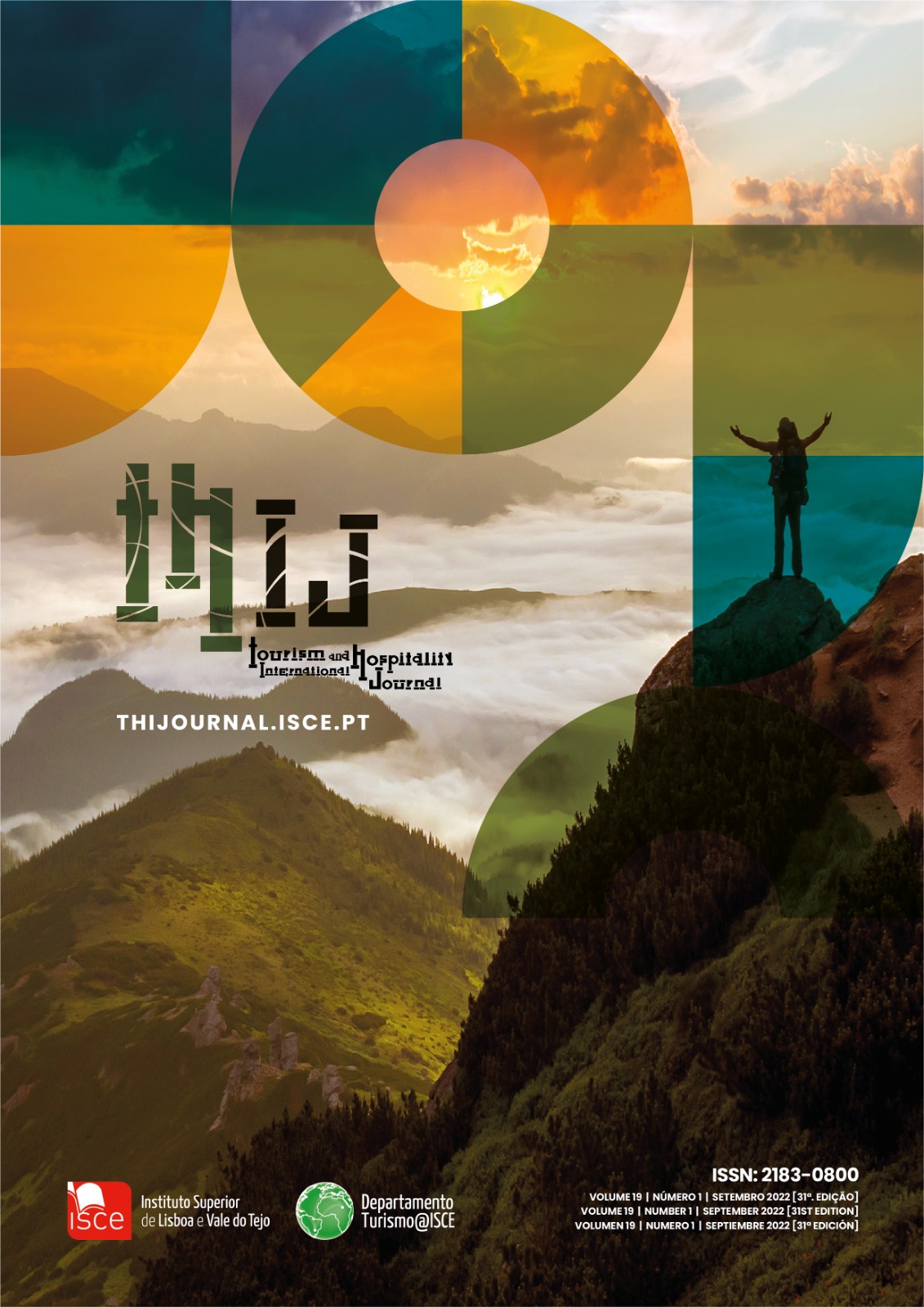Turismo criativo e património imaterial no Alentejo: O caso dos ‘Bonecos de Meia’
DOI:
https://doi.org/10.57883/thij19(1)2022.29746Palavras-chave:
Turismo Criativo, Património Imaterial, Desenvolvimento, Sustentatbilidade, Turista criativoResumo
O património cultural imaterial está relacionado com a criação cultural (saber-dizer e saber-fazer) de uma determinada comunidade. Ele é transmitido de geração em geração, especialmente, através da herança cultural e histórica. O turismo criativo tem, de certa forma, a sua base no património cultural imaterial. O presente artigo tem como objetivo principal descrever a atividade cultural criativa ‘bonecos de meia’ oferecida pelo projeto ‘Saidas de Mestre’ da MARCA-ADL (Associação Desenvolvimento Local). Para atingir o objetivo seguiu-se uma metodologia qualitativa baseada na observação não-participante. Os resultados mostraram que a atividade permite uma experência educativa memorável para os participantes.
Referências
Altinay, L. & Paraskevas, A. (2008). Planning research in hospitality and tourism. Amsterdam, Butterworth-Heinemann.
Ali, F.; Ryu, K. & Hussain, K. (2016). Influence of experiences on memories, satisfaction and behavioral intentions: A study of creative tourism. Journal of Travel &Tourism Marketing, 33(1), 85-100. https://doi.org/10.1080/10548408.2015.1038418.
Blapp, M. & Mitas, O. (2018). Creative tourism in Balinese rural communities. Current Issues in Tourism, 21(11), 1285-1311. https://doi.org/10.1080/13683500.2017.1358701.
Carvalho, R.; Costa, C. & Ferreira, A. (2019). Review of the theoretical underpinnings in the creative tourism research field. Tourism & Management Studies, 15(SI), 11-22. https://doi.org/10.18089/tms.2019.15SI02.
Ferreira, A., Gonzalez, E. & Liberato, D. (2018). Turismo criativo e sustentabilidade territorial. XX Congreso Internacional de AECIT’Conocimiento, creatividad e innovación: hacia el turismo del futuro’, p.1-17. https://aecit.org/files/congress/20/papers/399.pdf.
Gonçalves, F. & Costa, C. (2017). A perceção dos visitantes do território do “Galo de Barcelos”: destino de turismo criativo. Revista Turismo & Desenvolvimento, 27/28, 1177-1194. https://doi.org/10.34624/rtd.v1i27/28.9845.
Gonçalves, F. & Costa, C. (2019). Modelo de desenvolvimento e implementação do turismo criativo. O caso do Galo de Barcelos. Revista Turismo & Desenvolvimento, 32, 25-36. https://doi.org/10.34624/rtd.v0i32.20438.
Korez-Vide, R. (2012). Promoting sustainability of tourism by creative tourism development: How far is Slovenia?. Innovation issues and approaches in Social Sciences, 6(1), 77-102. http://dx.doi.org/10.12959/issn.1855-0541.IIASS-2013-no1-art05.
Marujo, N. (2012). A observação participante na investigação em turismo. TURYDES – Revista de Investigación en Turismo y Desarrollo Local, 5(13), 1-10. Disponível em https://www.eumed.net/rev/turydes/13/investigacion-turismo-resum.html.
Marujo, N., Borges, M.R. & Serra, J. (2020). O projeto CREATOUR. In N. Marujo, N. et al (Eds.), Turismo criativo no Alentejo: A experiência do projeto CREATOUR (pp.17-38). Castelo Branco, Caderno do Século.
Marujo, N., Borges, M.R., Serra, J. & Lourenço, P. (2020). Handicraft and creative tourism: The ‘Mãos de Cá’ project. In S. M. Cabeça et al (Eds.), Creative tourism dynamics: Connecting travellers, communities, cultures, and places (pp. 171-179), Grácio Editor, Coimbra.
Marujo, N., Serra, J. & Borges, M.R. (2020). The creative tourist experience in the Alentejo region: A case study of the CREATOUR project in Portugal. In A. Rocha et al. (eds.), Advances in tourism, technology and smart systems. Smart Innovation, Systems and Technologies, 171, 705-714, Springer, Singapore. Disponível em https://link.springer.com/chapter/10.1007/978-981-15-2024-2_60.
Marujo, N.; Borges, M.R.; Serra, J. & Coelho, R. (2021). Strategies for creative tourism activities in pandemic contexts: The case of the ‘Saídas de Mestre’ project. Sustainability. 13(19), 10654, 1-17. https://doi.org/10.3390/su131910654.
Masoud, H.; Mortazavi, M. & Farsani, N. (2019). A study on tourists' tendency towards intangible cultural heritage as an attraction (case study: Isfahan, Iran). City, Culture and Society, 17, 54-60. https://doi.org/10.1016/j.ccs.2018.11.001.
Mckechnie, L. (2008). Observational Research. In Given, L. (Ed.), The sage encyclopedia of qualitative research methods. London, Sage Publications.
Park, H. (2011). Shared national memory as intangible heritage. Re-imagining Two Koreas as One Nation. Annals of Tourism Research, 38, 520-539.https://doi.org/10.1016/j.annals.2010.11.013.
Raymond, C. (2007). Creative tourism New Zealand: The practical challenges of developing creative tourism. In G. Richards, e J. Wilson (Eds.), Tourism, creativity and development, pp. 145-157, London, Routledge.
Richards, G. (2010). Tourism Development Trajectories-From Culture to Creativity?. Tourism & Management Studies, 6, 9-15.
Richards, G. (2011). Creativity and tourism. The state of the art. Annals of Tourism Research, 38(4), 1225-1253. https://doi.org/10.1016/j.annals.2011.07.008.
Richards, G. (2019). Creative tourism: Opportunities for smaller places?. Tourism & Management Studies, 15 (SI), 7-10. https://doi.org/10.18089/tms.2019.15SI01.
Richards, G. & Raymond, C. (2000). Creative tourism. ATLAS News, 23, 16-20.
Richards, G. & Wilson, J. (2006). Developing creativity in tourist experiences: A solution to the serial reproduction of culture?. Tourism Management, 27(6), 1209-1223. https://doi.org/10.1016/j.tourman.2005.06.002.
Richards, G. & Wilson, J. (2007). Tourism development trajectories. From culture to creativity?. In G. Richards, & J. Wilson (Eds), Tourism, creativity and development (pp. 1-34). London, Routledge.
Santos, J. & Silva, J. (2016). Arte popular criativa e turismo cultural na cidade de Loulé (Algarve/Portugal). Revista Brasileira de Pesquisa em Turismo, 10 (2), 212-232.
Sousa. A. (2005). Investigação em educação. Lisboa: Livros Horizonte.
Sousa, B.; Vareiro, L.; Coelho, D.; Mota, L. & Silva, F. (2019). Criatividade no turismo e envolvimento do visitante: O estudo de caso de Loulé (Portugal). Revista Iberoamericana de Turismo- RITUR, 9 (1), 62-77. https://doi.org/10.2436/20.8070.01.129.
Tan, S; Kung, S. & Luh, D. (2013). A model of ‘creative experience’ in creative tourism. Annals of Tourism Research, 41, 153-174. https://doi.org/10.1016/j.annals.2012.12.002.
Tan, S; Luh, D. & Kung, S. (2014). A taxonomy of creative tourists in creative tourism. Tourism Management, 42, 48-259. https://doi.org/10.1016/j.tourman.2013.11.008.
UNESCO (2003). Convention for the safeguarding of the intangible cultural heritage. Disponível em https://ich.unesco.org/doc/src/15164-EN.pdf. Acedido a 25/02/2022.
UNESCO (2006). Towards sustainable strategies for creative tourism - Discussion report of the planning meeting for 2008 International Conference on Creative Tourism. Santa Fe, New Mexico, USA. Disponível em https://unesdoc.unesco.org/ark:/48223/pf0000159811. Acedido a 25/02/2022.
Virginija, J. (2016). Interaction between cultural/creative tourism and tourism /cultural heritage industries. In L. Butowski (Ed.), Tourism-from empirical research towards practical application, (pp. 137-157). Rijeka, InTech.
Downloads
Publicado
Como Citar
Edição
Secção
Licença
Direitos de Autor (c) 2022 This work is licensed under a Creative Commons - Attribution 4.0 International (CC BY 4.0)

Este trabalho encontra-se publicado com a Licença Internacional Creative Commons Atribuição 4.0.
Este trabalho encontra-se publicado com a Licença Internacional Creative Commons Atribuição 4.0.






